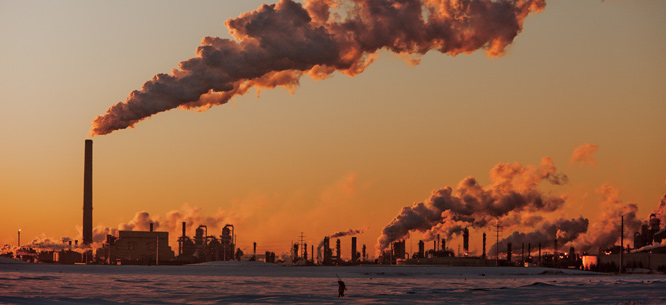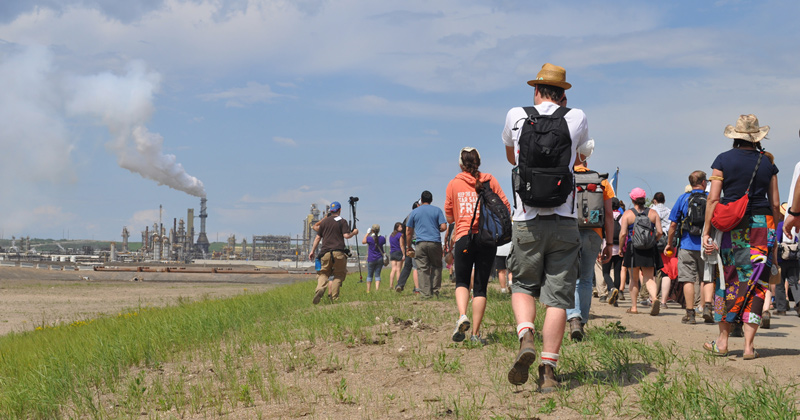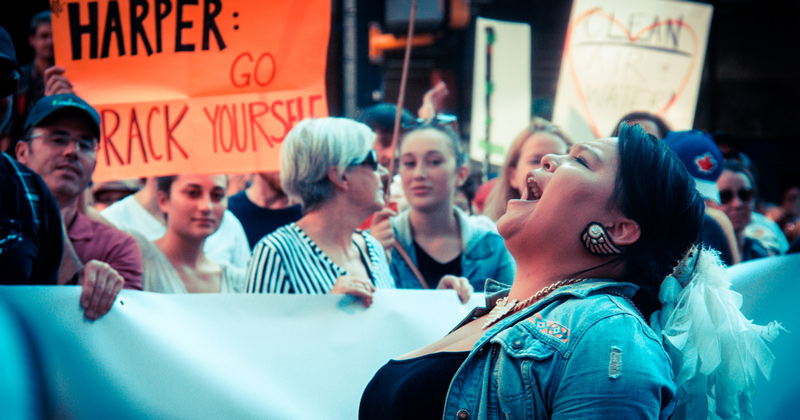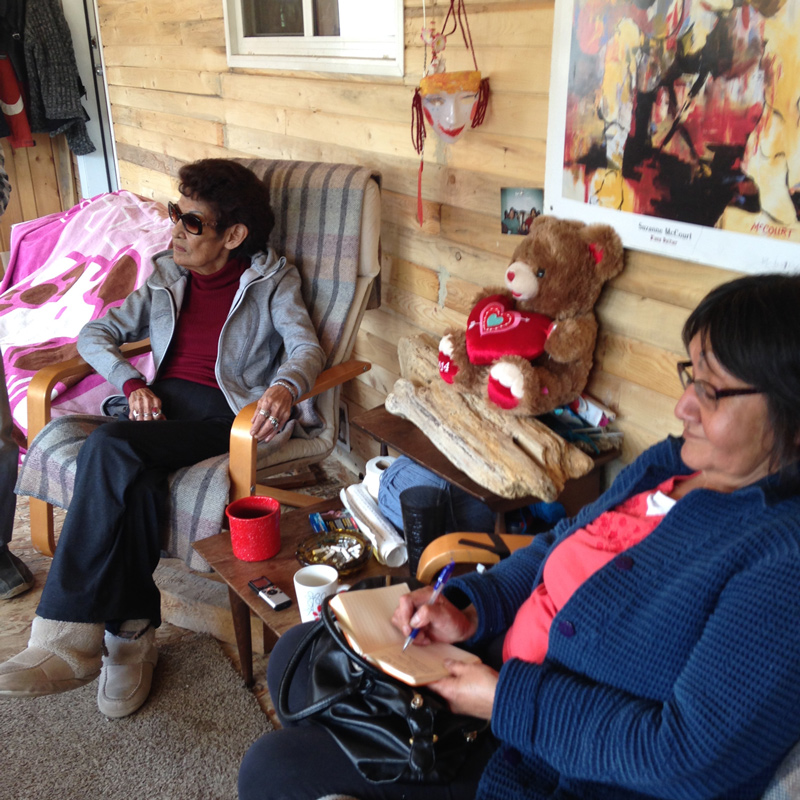Game Over for the Tar Sands?
Game Over for the Tar Sands?
Plunging oil prices, indigenous-led protests, and a new, liberal government have called the future of the tar sands into question. But will all this be enough to defuse Canada’s “climate bomb” for good?

The first time I met her, Nancy Scanie was like Moses, wooden staff in hand, body draped in a shawl, as she led a slow-moving march across barren land.
This was the summer of 2014, and I was on the Tar Sands Healing Walk through the heart of the oil developments in northern Alberta. Attended by hundreds of activists and supporters from across North America, the Healing Walk was an indigenous-led procession seeking to renew the participants’ spiritual connection with the land and allow them to bear witness to the destruction wreaked by tar sands mining. The sites we passed on the Walk included gaping mines, pools of toxic waste known as “tailings ponds,” and smoke-spewing facilities where bitumen is isolated and converted into lighter oil. All of this is occurring on traditional indigenous lands covering an area roughly the size of England.
The tar sands—or oil sands, as the industry refers to them—are a semi-solid form of oil (also called bitumen) mixed with sand and silt. Their extraction has reaped tens of billions in revenue for oil companies and generated hundreds of thousands of jobs across Canada, but is also extremely environmentally destructive and carbon-intensive to produce. The continued exploitation of the tar sands will have such devastating global environmental and economic consequences, in fact, that climate expert James Hansen warned in 2012 that “if Canada proceeds . . . it will be game over for the climate.”
Now seventy-seven years old, Scanie is a Cold Lake Dene First Nations elder who also serves as Clan Grandmother to the Keepers of the Water, an indigenous-led environmental advocacy organization active in Western and Northern Canada. A diminutive woman with Jackie O sunglasses covering nearly half her face, she had travelled four hours north from her home in Cold Lake, the boomtown in a different tar sands-producing region of the province. “I don’t want to return there now. It’s all dead,” she spat, recalling the abundance of plants and animals that used to populate the area where she was born, not far from where she lives now. Those forests were recently the site of a major leak at Primrose—a tar sands project owned by one of the country’s largest oil companies, Canadian Natural Resources Limited (or CNRL)—that went on for over a year and a half.
Scanie had been part of every Healing Walk since it began five years earlier, and had watched it grow considerably, from just a handful of people to over 500 participants the year Naomi Klein and Bill McKibben attended. “We’re in a very bad predicament,” she said of the oil developments surrounding us. “But every time we do a Walk, the support we get from all over Canada and the U.S.A. is something else.”
It’s been less than two years since that last Healing Walk, but for Albertans, 2014 now feels like a distant time: oil was trading at more than $100 a barrel, Keystone XL seemed destined for approval, and arch-conservative Prime Minister Stephen Harper was still maniacally demolishing the country’s environmental regulatory system. Tar sands production, which had been expanding steadily since the mid-1970s, was growing faster than ever.
Today, plunging oil prices have sent Alberta into an ever-deepening recession; climate change is defining presidential legacies; and opposition to the tar sands has ballooned, with significant popular protests breaking out along proposed pipeline routes across Canada. These include Enbridge’s Northern Gateway and Kinder Morgan’s Trans Mountain pipelines in British Columbia, as well as TransCanada’s Energy East, which will stretch nearly the entire length of the country to the Atlantic coast. Could all of this spell a permanent end to tar sands expansion?
“I’ve never seen this before,” said Scanie of the popular movement when we spoke in late December. She and other indigenous residents in Alberta’s vast tar sands regions have long had their objections to the developments ignored and dismissed, but they now find themselves with allies in far-flung places, not only from communities along the vast network of pipelines, but also among liberal-minded Canadians elsewhere, who have begun to accept the realities of climate change and acknowledge Canada’s history of violence toward its native residents.
A renewed sense of optimism has taken hold among liberals and progressives nationwide since Liberal leader Justin Trudeau was elected prime minister in October, ousting the much-hated Harper. Some indigenous activists, too, see Trudeau as an ally and hope he will usher in a greener, more egalitarian future for Canada. Scanie recently filmed a prayer for him in which she is standing on a windy beach. “Give him the ability to do something good, oh heavenly father,” she implores, vestiges of her Christian, residential-school education peeking through. (This sordid chapter of Canadian history, which did not end until 1996, saw 150,000 indigenous children separated from their families and forced to attend the religious schools, where they were dispossessed of their own culture and often abused.) Why, I asked Scanie, had she felt compelled to send Trudeau a prayer? “I want him to be a good prime minister and treat everyone equally,” she explained. “I have a feeling that he’s going to do good.”
Whether Trudeau can, or will, “do good” for Scanie—and for the climate—depends in large part on whether his reforms will strengthen the control of indigenous people over their land and resources in a meaningful way. This would involve reforming environmental regulations to give First Nations and local communities a much larger say in how oil and gas resources are developed on their lands. But Trudeau’s willingness to do so will be tested by anxieties about Alberta’s economic future, as the fate not only of the tar sands but of a vast swath of Canada’s working people hangs in the balance.
The dramatic shifts that Scanie described—the precipitous growth of climate and indigenous activism—can partially be chalked up to the strength of the social movements that she’s a part of. Touching off the current groundswell was Harper’s introduction of the omnibus Bill C-38 in 2012, which amended dozens of pieces of legislation and severely rolled back federal environmental regulations in violation of indigenous treaty rights. The response from indigenous activists was swift. Within weeks, what began as a hunger strike by a single chief in Ontario had snowballed into a robust nationwide movement, reaching far beyond the metropolitan centers to remote rural communities.
Like Occupy, the Idle No More movement largely faded from mainstream consciousness after several months, but the connections it forged at the grassroots level continue to amplify the voices of indigenous communities nationwide. This has pushed many of their concerns, long deemed un-newsworthy, to the forefront of public debate. Shortly after taking office in November, Trudeau vowed a renewed relationship with First Nations peoples, announcing the repeal of Harper-era legislation. He also assured implementation of recommendations from the Truth and Reconciliation Commission report on residential schools (which range from poverty reduction measures to seeking an apology from the Pope). Trudeau has additionally promised a national inquiry into the 1,200 cases of “Missing and Murdered Indigenous Women” reported since the late 1970s, something that families of victims have been unsuccessfully trying to call attention to for decades.
Trudeau’s promises are less clear, however, when it comes to native land rights—an issue that lies at the core of the indigenous movement, and that even the oil industry recognizes has the potential to stop any proposed pipeline in its tracks. In their demand for greater control over traditional lands, indigenous activists seek not only the same rights afforded to other Canadians but sovereignty and self-determination over their own communities.
The basis of this argument is that First Nations bands who ceded their territories to the British crown in the late nineteenth century did so in exchange for the right to hunt and fish on their traditional lands in perpetuity, while also retaining full jurisdiction over much smaller reserves. Today, the dispossession of native land continues as the Crown—the federal government—disburses leases and mineral rights on these lands to oil and gas companies. But several indigenous communities whose traditional territories house tar sands developments are challenging this land grab in the courts. Some are targeting specific developments while others are challenging broader government land-use plans. All, however, are arguing that First Nations have a right to be consulted about how these lands are used—which would include the right to veto any new developments.
In the court of public opinion, this position has gained rapid ground since 2014, when the Supreme Court of Canada ruled in Tsilhqot’in Nation v. British Columbia that aboriginal title takes precedence in territories that were never ceded through treaties to the Crown, meaning that bands have substantial authority over how those lands are used. This has provided a crucial moral argument to the burgeoning climate movement, and a way to frame fossil fuel expansion as an issue of constitutional rights.
Several key pipeline projects have been challenged on this basis, including the Northern Gateway and Trans Mountain pipelines running through British Columbia to the Pacific coast. The former, widely opposed by local communities but nevertheless approved by the National Energy Board (NEB) in 2014, prompted a federal lawsuit from eight BC First Nations and set off mass protests throughout the province. Residents and activists vowed to erect blockades if necessary. Before long, even larger protests broke out near Vancouver over the Trans Mountain pipeline, this time over specific accusations that the NEB hearing process was rigged in favor of industry. The protest was no longer just about environmental safety and health, but about democracy.
The NEB process is meant to give local communities and First Nations a say over any new interprovincial energy pipelines. In the eyes of protesters, however, the board’s greenlighting of two vastly unpopular pipelines exposed it as little more than a kangaroo court. Soon the outrage spread beyond BC, drawing calls for reform from across Canada. What had begun several years earlier as a localized Alberta fight over tar sands development has since grown into a national debate about the right of indigenous communities to determine how their traditional lands are used, and about the trampling of democratic rights by industry and the NEB. Today both industry and government concede that Northern Gateway, unable to overcome First Nations opposition and win a popular local mandate, will likely never be built.
Meanwhile mediaworthy protests over Keystone XL, along with the 2014 People’s Climate March in New York, had helped push the issue of global warming to the forefront of public debate, and political leaders in both the United States and Canada started falling in line. In May 2015, as Barack Obama warned that “climate change constitutes a serious threat to global security” and urged immediate action, Alberta unseated a forty-four-year conservative dynasty to welcome a social democratic premier, Rachel Notley of the New Democratic Party (NDP). Notley had promised to tighten environmental standards and review the province’s royalty system, as Alberta’s royalty cut on energy revenues was considered extremely low. Just before COP21 began in November, the province announced a new “Climate Leadership” plan introducing a carbon tax, phasing out coal power by 2030, and capping tar sands carbon emissions at 100 megatons per year. The plan was widely celebrated as a game changer, receiving enthusiastic praise from high-profile environmental advocates including Al Gore.
Alberta’s promises of bold climate action were mirrored at the national level. Led by the newly elected Trudeau (who had already won over many skeptical progressives with a series of symbolic gestures, including appointing a cabinet that boasted gender parity and racial diversity), the Canadian delegation left for Paris in November proudly waving the flag of change. Would Canada finally depart from Harper-era policy and agree to provisions to cap global warming to 2°C? No, announced environment minister Catherine McKenna at the climate talks: Canada wanted a cap of 1.5°C! And McKenna’s camp prevailed: in an apparent victory for the small island nations and grassroots groups who were the first to champion it, the 1.5°C target made its way into the final text of the Paris agreement. “Canada is back, my friends,” declared Trudeau with characteristic charm.
The backdrop to this rosy picture is a crippling recession (expected to last into 2019) that has already resulted in a loss of 40,000 oil-industry jobs nationwide and a doubling in the number of Albertans collecting unemployment benefits, as companies seek to adjust to an inhospitable oil market through mass layoffs. Many companies have withdrawn plans to construct new tar sands projects until oil prices bounce back, in what environmental groups have celebrated as a victory. The economics of tar sands expansion were only further strained by the cancellation of Keystone XL; if Northern Gateway is out of the picture as well (Notley and Trudeau now agree that it should not be built), companies will find it harder than ever to get their crude to market.
Politicians and industry often like to remind naysayers that Alberta weathered a nasty fall in oil prices in 2008–09, from nearly $150 per barrel to $34 per barrel, and companies could well ride out a more dramatic recession. But this time, the political winds are fickle, too. Will revised protocols for the NEB (and its provincial equivalent, the Alberta Energy Regulator) and tighter environmental regulations make further tar sands expansion permanently unprofitable? Despite a widespread sense of gloom among laid-off workers and economically depressed Alberta communities, Big Oil is not yet packing its bags. “I think with good old Alberta innovation, we’re going to come through and be able to manage it,” Alberta Energy Minister Margaret McCuaig-Boyd recently told NPR.
Indeed there are many ways that industry might “innovate.” Faced with resistance to new pipelines, companies are finding ways to expand existing ones and free up resources through a combination of financial restructuring and technological improvements. Mergers and acquisitions could allow others to consolidate operations and lower costs (while smaller companies might be bankrupted out of existence). However, these adjustments might be unable to counterbalance the stronger caps on carbon emissions that the Alberta plan calls for, alongside reforms to the NEB process and its Alberta equivalent, which would expand public participation and aboriginal consultation in the reviews process.
It’s hard to predict exactly how all of these factors will add up on the balance sheet, but one thing is clear: stopping tar sands expansion is above all a question of political will. However, Notley herself has denied that it’s her goal. When asked whether the new emissions cap would prevent further tar sands growth, Maclean’s reported, she simply “furrowed her brow and said no.” This could just have been a PR move to assuage her province’s all-powerful industry. Notley’s subsequent policy moves have only further comforted oil CEOs. The royalty review, released in late January, ultimately proved a major about-face from Notley’s election campaigning about Alberta’s royalty regime being too lax; the review indicated that Alberta’s royalty rates were actually comparable to the rest of the world, and Notley announced that there would be no major changes to the regime.
Meanwhile, estimates have shown that the province’s new climate plan won’t cost oil companies more than around $1 per barrel. Moreover, its widely celebrated 100 megatons per year emissions cap is not only an increase from the current emissions level of 70 megatons per year, allowing ample room for expansion, but was also the product of secret negotiations between four major tar sands companies (Shell, Cenovus, CNRL, and Suncor) and four environmental groups (Forest Ethics, Pembina Institute, Greenpeace Canada, and Equiterre), who agreed in exchange to back down on their opposition to new pipelines. “I’m hopeful that these policies, taken overall, will lead to a new collaborative conversation about Canada’s energy infrastructure on its merits, and to a significant de-escalation of conflict worldwide about the Alberta oilsands,” said Notley at the announcement of the climate plan. A vehement supporter of the Trans Mountain and Energy East pipelines, she simply opposes projects like Northern Gateway that most clearly lack a popular mandate (while Trudeau, since taking office, has remained strategically silent about which pipelines he supports).
Their fates undecided as they await judgment before the NEB, the Trans Mountain and Energy East pipelines are now ground zero for climate activists. Driving the activists is the knowledge that new pipelines will only facilitate tar sands expansion, even as climate scientists have shown that virtually all of the untapped tar sands deposits must stay in the ground if the world is to meet even a 2-degree goal. If major environmental groups, like the four involved in the secret deal, have played a role in pushing the issue of climate and tar sands into the mainstream, it is now up to local communities across Canada to take these fights into their own hands.
The new climate plan, whatever its flaws, is Alberta’s clearest acknowledgement to date that the fossil-fuel era must come to an end, with provisions to increase the use of renewable energy in the province’s electricity grid to as much as 30 percent by 2030. The plan also calls for a chunk of carbon tax revenues to be spent on supporting a “just transition” to renewables, through retraining programs for workers and consumer rebates to offset increased fuel, electricity, and heating costs. But even these promises come layered in contradictions, as mass anxiety about the loss of oil jobs has stoked public concern about whether Alberta oil—and by extension, the Canadian economy—can stay competitive when profit margins in the U.S. shale fields are so much higher. For one, the plan stipulates that, alongside green-jobs funding, revenues from the carbon tax will also be used to help oil companies offset their increasing costs—including from the tax itself. For this reason, the construction of new pipelines may be the crucial variable determining whether tar sands production remains profitable or not.
In the meantime, the climate plan is being deployed to greenwash the tar sands, showing the world that the industry is now operating under new and improved environmental guidelines. Cenovus—one of the four companies involved in the secret negotiations—announced just as the Paris summit was concluding that it was forging ahead with expansion plans at two of its main developments, Christina Lake and Foster Creek, which will add 50,000 barrels per day to production by 2017. Cenovus’s bottom line, said CEO Brian Ferguson, would not be impacted by the emissions cap. “There’s an emissions limit, not a production limit,” he said. Cenovus’s bottom line will no doubt be aided by the fact that the improved technology means not only fewer emissions but also fewer workers: “at one of Christina Lake’s well pads, [producing] a combined 12,000 barrels per day of oil,” an industry journal boasts, “there are a total of zero workers on site.”
Foster Creek is Cenovus’s largest tar sands project. It’s located inside the Cold Lake Air Weapons Range, Canada’s only tactical bombing range, just a few hours east of Edmonton and about four hours south of Fort McMurray, where media coverage of the tar sands has been concentrated. This is where Nancy Scanie was born in 1939, before the military arrived and the Department of National Defense began guarding its gates. Growing up inside the range at Primrose Lake, she recalls, the forest was filled with moose, and in the wintertime everyone lived in log cabins on the shore, each with their own trapline to provide a bounty. This ended in 1953, when the federal government signed an agreement with Alberta to lease the land. Since then, Scanie’s band, the Cold Lake First Nations, have been locked out, with limited weekend access to only small stretches of the 1.6 million-acre range for hunting, fishing, and gathering.
For the last twenty years, the range has also become home to many multinational oil companies, whose current operations provide a glimpse into the “green” future of the tar sands. Like the rest of the deposits underlying 97 percent of Alberta’s tar sands surface area, the bitumen in this region is too deep to be mined, and requires more advanced extraction technologies like thermal in situ, where steam is injected into the ground, effectively liquefying the oil so it can be pumped back out. Although this method has historically produced more carbon emissions than mining, industry analysts claim these are being drastically reduced through technological innovations, while the method itself is less destructive than surface mining (it forgoes the need for the open-pit mines, smoke-spewing purification facilities, and toxic dumping sites). But a series of leaks and blowouts in the area have also raised serious questions about the thermal wells’ environmental safety, including major leaks on CNRL and Cenovus sites within the range.
Last spring, I visited Scanie at her home on the reserve. In the town of Cold Lake, tidy streets of large, suburban homes stretched along the marina, the eponymous lake beyond it lying completely still. But the scenery grows more austere along the road out of town, heading toward the reserve. Cold Lake’s groomed, majestic houses give way to newer cookie-cutter suburban developments and then eventually to a gravel road, where Scanie’s little house was tucked in a clearing in the woods. This is on the opposite end of town from the Canadian Forces Base that accounts for much of Cold Lake’s population; it is an area that has largely been deprived of the wealth produced by the oil developments. Still, Scanie’s cedar house is her own domain: lavender roasts on the wood stove, and four generations of her family live within, her great-granddaughters periodically bursting through the doors with new discoveries from the yard.
For most of her adulthood, Scanie lived abroad as a military wife and later in eastern Canada, having left home at eighteen to escape the violence. Seventy years have passed, but the images from residential school remain fresh in her mind: the mounted police arriving on the reserve and ordering parents to load their children onto a cattle truck; the long ride to the town of St. Paul, over 100 kilometers away, with the kids forced to stand the entire way; all the times she was hit by a nun; and the one time, at age sixteen, when she finally hit back and was punished with a shaved head and thirty lashes in front of all the other kids. “No one is ever going to be the boss of me again,” she told herself after being “dishonorably discharged” from school. She traveled to France and Germany, where extravagant military balls awaited, before settling in a house of her own in eastern Canada. Life there was generally good, she recalls, and her departure from home might have been permanent were it not for a bout of cancer in the late 1970s. Lying in a Halifax hospital on the brink of death, Scanie had her breasts and stomach lining removed, but it wasn’t until she returned to Alberta that she was really able to heal. Back in the Cold Lake region, a native doctor nursed her back to health with local traditional medicines, reconnecting her to her land and, as she put it, giving her back her life.
Scanie has remained in Alberta ever since, her relationship to home renewed, in spite of the years she later spent in Fort McMurray (nicknamed “Fort McMoney”), where her husband worked in the tar sands until retirement. This contradiction—that the land she calls home remains populated by oil developments, which are also the region’s largest source of well-paying jobs—plagues northern Alberta. But activists are hopeful that jobs in green energy and other sustainable sectors could eventually replace those lost in the oilpatch.
Scanie hopes that Canada’s change in leadership will allow her community to break out of the cycle of poverty and abuse that is the lasting legacy of forced assimilation and resettlement policies. She imagines this will include better resources for cultural education, to reconnect the youth with their land and roots—much as the native doctor once did for her. But it would also mean creating a sustainable economy that provides local jobs and doesn’t sever the community’s ties to the earth. Some of these jobs might be in renewable energy, while others in community education, youth programs, and arts and handicrafts could help the local culture to thrive. “I would like our land back,” said Scanie with the same air of optimism that has seized much of liberal Canada. “Something good is going to happen in the future. People have started to listen to what we’re saying.”
For now, this newfound optimism sits uneasily with other Albertans, who feel threatened as the decades-old promise of a prosperous, tar sands-driven future wavers. Long considered a bastion of conservatism, populated by the loudest cheerleaders of industry, Alberta may soon face an identity crisis, although the oil industry still remains very much at its heart, both culturally and economically. Winning over average Albertans—especially the hundreds of thousands whose livelihood depends on the tar sands—to the prospect of a future without oil will take a concerted effort on the part of the government to promote clean jobs, above and beyond those held out by its current climate plan. In this endeavor, the NDP still has a long way to go.
Meanwhile, less recognized outside the province, a cultural shift is already taking place. In the last twenty-five years, Calgary—Canada’s oil capital and Alberta’s largest city—has nearly doubled in size. The oil-industry families that once dominated it are becoming a minority in a culturally thriving and increasingly cosmopolitan city that attracts young migrants from all around the country and the world (including its much-beloved progressive Muslim mayor Naheed Nenshi, who arrived from Toronto as a child). It is no longer as conservative as most Canadians might believe, and an economic shift away from oil is no longer inconceivable. Canada is already far less reliant on oil than many Canadians believe; economist Andrew Leach points out that over the last twenty years, the energy-sector share of Canada’s GDP has even declined, from more than 12 percent in 1997 to 9 percent today. And crude oil production accounts for only about a third of that.
“We never relied on oil when we were young, never mind the gold and silver,” said Scanie. “We never even knew what oil was.”
The tar sands, after all, have only been in production for forty years, and only in the last few years did the vast majority of North Americans even learn of their existence. Scanie recalls living without the tar sands as if it were yesterday.
“We can do it again,” she said with an air of nonchalance.
Audrea Lim is a journalist and editor based in Brooklyn. Her work has appeared in the Nation, Al Jazeera America, and the New Yorker.










